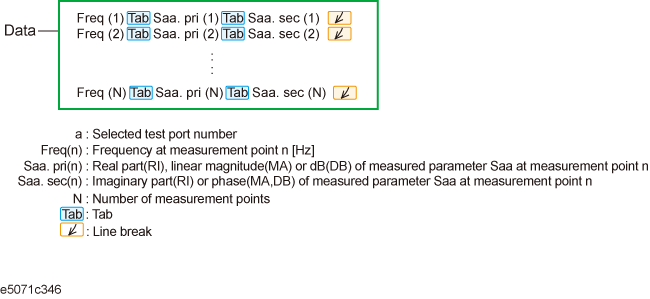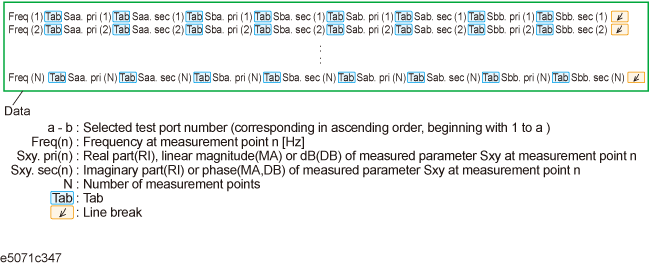
Other topics about Data Output
The E5061B allows the user to save data for the active trace on the active channel to a CSV file (file extension *.csv) and to load the data into PC application software for further processing.
Trace data are saved in the format shown below.
"# Channel 1"
"# Trace 1"
Frequency, Formatted Data, Formatted Data
+3.00000000000E+005, +1.41837599227E-002, +1.43446459328E-006
+4.27985000000E+007, +1.41275293412E-002, +2.02407834551E-004
+8.52970000000E+007, +1.41334093048E-002, +4.00643331604E-004
+1.27795500000E+008, +1.41240661092E-002, +6.09250514670E-004
+1.70294000000E+008, +1.41402155348E-002, +8.05620003993E-004
The first line shows the number of the active channel at the time the data is saved.
The second line shows the number of the active trace at the time the data is saved.
The third line is a header line indicating the contents of each item of trace data written on the fourth line onward.
The fourth line onward shows the trace data. The amount of data is determined by the number of points (frequency) assigned to the trace.
Follow the procedure below to save trace data from the E5061B.
Press Channel Next (or Channel Prev) and Trace Next (or Trace prev) to select the trace to be saved.
Press Save/Recall > Save Trace Data to open the Save As dialog box.
Select the destination folder and input a file name.
Click Save to save the file.
This function is inactive when the security level is set at low/high.
You can also save trace data of a E5061B active channel of S-parameter to a Touchstone format file. This function is not available under the impedance measurement (option 005).
You can save data in "log magnitude - angle", "linear magnitude - angle", or "real number - imaginary number."
When AUTO is selected, the data format is automatically set according to the display format of the active trace. However, when the display format of the active trace is set to one other than the log magnitude format (LogMag), linear magnitude format (LinMag), or real-imaginary number format (Real/Imag), the data format is automatically set to real-imaginary number.
You can use data saved in Touchstone format for a circuit simulator such as Keysight Advanced Design System (ADS) on your PC (personal computer) or workstation. For more information on the ADS, refer to the operation manual that comes with the system.
File types of the E5061B Touchstone files are s1p and s2p. The file type indicates the number of ports of the data structure that is output to the Touchstone file.
Data structure of the Touchstone file consists of a header part and a data part. The contents of the file is text data, which is ready to be read with a general text editor.
The header part consists of the returned value of *IDN?, file created date, calibration state, list of all S parameters of a specified port, and format information.
The header parts of s1p and s2p are shown below.
!Keysight Technologies,E5061B,<ID>,<FW Revision>
!Date <Date>
!Data & Calibration Information
!Freq Syy:Method(Stat)
# Hz S FMT R Z0
!Keysight Technologies,E5061B,<ID>,<FW Revision>
!Date <Date>
!Data & Calibration Information
!Freq Syy:Method(Stat) Syz:Method(Stat) Szy:Method(Stat) Szz:Method(Stat)
# Hz S FMT R Z0
Each item has the following meaning:
|
Parameter |
Description |
|
Syy to Szz |
S parameters of the selected test port; corresponds in ascending order, beginning with y to z. |
|
Method |
Calibration type applied to S parameter. |
|
Stat
|
State of S parameter calibration and error correction setting (ON, OFF, or --) ON = Error correction is set to ON |
|
FMT |
Data format RI = Real number - imaginary number |
|
Z0 |
Reference impedance value |
The structure of the data part depends on the combination of the selected file type and specified port.
When the S parameter of a port on which calibration is not performed is specified, if the data measured with the S parameter exists, that data are output to a Touchstone file. If no measurement data exists, 0 (for log magnitude - angle, log magnitude = -200 dB) is output in the corresponding field.
The following figures show the data structures of files saved in Touchstone format.
1-port Touchstone file

2-port Touchstone file

Restrictions when saving data in Touchstone format
The following restrictions apply in saving measurement data into Touchstone format.
When both fixture simulation and port impedance conversion are ON, all Z0 of the ports to be saved must be set to the same value. If Z0 is different among the ports, no error occurs, but only the Z0 of the smallest port number is output to the header.
When the time domain function is ON, the saved data are not the displayed data but the data of the S parameter before conversion.
For data saved in touchstone format, data operation, time domain, parameter conversion, data format, electrical delay, equation editor, and smoothing are not reflected in the output data.
Follow the steps below to save trace data in Touchstone format.
Press Channel Next (or Channel Prev) and Trace Next (or Trace prev) to select the trace to be saved.
Press Save/Recall > SnP > SnP Format.
Click the softkey that corresponds to the data format you want to save.
|
Softkey |
Function |
|
Auto |
Data format is automatically set according to the display format of the active trace. When the display format of the active trace is set to one other than log magnitude format (LogMag), linear magnitude format (LinMag), or real-imaginary number format (Real/Imag), the data format is automatically set to real-imaginary number. |
|
LogMag/Angle |
Select "log magnitude - angle" data format |
|
LinMag/Angle |
Select "linear magnitude - angle" data format |
|
Real/Imaginary |
Select "real - imaginary number" data format |
Click the softkey for s1p or s2p according to the file type you want to save.
Click the softkey that corresponds to the combination of ports that you want to save.
SaveAs dialog box opens. For its operations, use an external keyboard and mouse.
Specify the folder to which the file should be saved, enter a file name, and then press Save to save the file.
When saving data in a sweep process, the data during sweep is saved into a Touchstone file. That is, the previous sweep data is saved as data that has not been swept; or, if sweep was not performed previously, zero data might be saved. Therefore, you should set the active channel to the HOLD state when saving data into a Touchstone file.
This function is inactive when the security level is set at low/high.